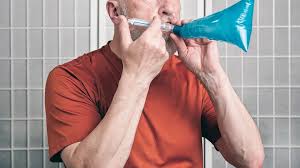 The best non-invasive test to detect an active H. pylori infection.
The best non-invasive test to detect an active H. pylori infection.
Patients ingest urea carbon labeled material which is hydrolyzed by H. pylori, if it is present , and it can be measured in the breath as 14CO2 or 13CO2.
The urea breath test is a rapid diagnostic procedure used to identify infections by Helicobacter pylori, a spiral bacterium implicated in gastritis, gastric ulcer, and peptic ulcer disease.
It is based upon the ability of H. pylori to convert urea to ammonia and carbon dioxide.
The urea breath test detects the characteristic enzyme urease, produced by H. pylori, by a reaction that produces ammonia from urea.
The urea breath test is a rapid diagnostic procedure used to identify infections by Helicobacter pylori, a spiral bacterium implicated in gastritis, gastric ulcer, and peptic ulcer disease.
It is based upon the ability of H. pylori to convert urea to ammonia and carbon dioxide.
Urea breath tests are recommended 7as a preferred non-invasive choice for detecting H. pylori before and after treatment.
Patients swallow urea labelled with an uncommon isotope, either radioactive carbon-14 or non-radioactive carbon-13.
In the subsequent 10–30 minutes, the detection of isotope-labelled carbon dioxide in exhaled breath indicates that the urea was split; this indicates that urease, which is the enzyme that H. pylori uses to metabolize urea to produce ammonia is present in the stomach, and hence that H. pylori bacteria are present.
The test measures active H. pylori infection.
Urea breath tests are recommended in leading society guidelines as a preferred non-invasive choice for detecting H. pylori before and after treatment.
If antibiotics are depressing the amount of H. pylori present, or the stomach conditions are less acidic than normal, the amount of urease present will be lessened: the test should only be performed 14 days after stopping acid reducing medication (proton pump inhibitors, PPI) or 28 days after stopping antibiotic treatment.
The test is especially performed accompanying an eradication therapy by antibiotics, to avoid overdosing, or to check the success of an ulcer operation.
This increases the pH, reduces the acidity, of the stomach environment around the bacteria.
Test of choice to demonstrate that an infection has been cured with treatment.
Post-treatment testing should allow four weeks after the end of treatment to detect any remaining infection.
Patients swallow urea labelled with an uncommon isotope, either radioactive carbon-14 or non-radioactive carbon-13.
In the subsequent 10–30 minutes, the detection of isotope-labelled carbon dioxide in exhaled breath indicates that the urea was split; this indicates that urease, which is the enzyme that H. pylori uses to metabolize urea to produce ammonia is present in the stomach, and hence that H. pylori bacteria are present.
The test measures active H. pylori infection.
If antibiotics are depressing the amount of H. pylori present, or the stomach conditions are less acidic than normal, the amount of urease present will be lessened: the test should only be performed 14 days after stopping acid reducing medication (proton pump inhibitors, PPI) or 28 days after stopping antibiotic treatment.
The test is especially performed accompanying an eradication therapy by antibiotics, to avoid overdosing, or to check the success of an ulcer operation.
